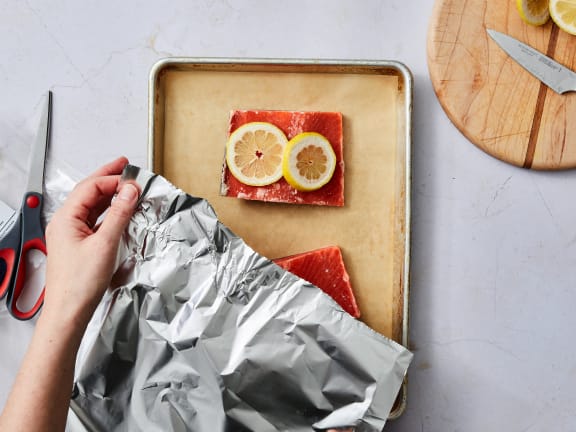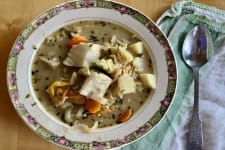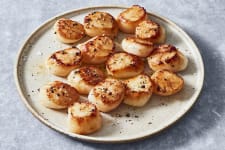So you want to bake salmon for dinner but forgot to take it out of the freezer to let it defrost. You're wondering: "Can you bake salmon from frozen?" The answer is yes! Baking frozen salmon, like pan-frying frozen salmon, is a simple way to eat your fish without waiting for it to thaw.
Cooking salmon from frozen in the oven requires very little prep, and it can be done in 45 minutes or less. For a thin salmon tail cut, expect dinner to take at least 35 minutes (including preheating time) from the freezer to your plate. Thicker, center-cut frozen salmon fillets can take longer.
Method 1: How to Bake Salmon from Frozen on a Baking Sheet
This method par-bakes frozen salmon fillets while covered with foil, allowing the fish to warm up quickly without drying out. Then, the salmon is finished uncovered until perfectly cooked.

You'll need: Your fillet(s), olive oil, salt and pepper, lemon, baking sheet or dish, aluminum foil, sauce or glaze
-
Preheat your oven to 425 degrees F.
-
Meanwhile, remove frozen salmon from packaging — choose fillets that are less than 1-inch thick, if possible — and place skin side down on the baking sheet. Arrange lemon slices over the tops of the fillets, then cover the dish with a tight-fitting lid or the pan with aluminum foil. Bake for 15 minutes without any seasonings or sauces.
- When 15 minutes are up, use a knife tip to check the thickest part of the fillet. If it's still frozen solid, let it parcook for a few more minutes. Otherwise, remove the lid/foil, season with salt and pepper, drizzle with olive oil, and add sauce.
- Bake uncovered for 8 to 12 minutes. Salmon is medium-well when the thickest part registers at 125F with an instant-read thermometer. Check the internal temperature with an instant-read thermometer to avoid overcooking.
Method 2: How to Bake Salmon from Frozen in the Oven on a Wire Rack
You can also bake salmon frozen on a wire rack set over a baking sheet. This method keeps the fish from becoming waterlogged and allows the skin to crisp while the center cooks.
You'll need: Your fillet(s), baking tray, wire rack, cooking spray, olive oil, salt and pepper, and a spatula.
-
Preheat the oven to 375 degrees F. Place a wire rack on a baking tray and spray it with cooking spray.
-
Place the salmon on the prepared baking tray and brush it with a thin layer of olive oil. Salt and pepper the fillet generously.
-
Bake your salmon for 24 to 26 minutes (120F to 125F internal temp.). Check the internal temperature with an instant-read thermometer so you don't overcook your meal.
How Long to Oven Bake Frozen Salmon
Frozen salmon cooking time depends on a few things: the size of the fillet, the cooking temperature, and the type of pan you use. While a thermometer is best for determining doneness, you can also rely on visual cues. Look for the center of the fish to be opaque, not translucent or icy, and it should look plump and juicy. Also, it should come off the wire rack cleanly when you lift it with a fish spatula. Here are some general guidelines:
How Long Should You Bake Salmon from Frozen at 400 Degrees Fahrenheit?
Baking still-frozen salmon at 400 degrees Fahrenheit typically takes 25 to 30 minutes.
How Long Should You Bake Frozen Salmon at 425 Degrees Fahrenheit?
Baking still-frozen salmon at 425 degrees Fahrenheit typically takes about 20 to 25 minutes.
Simple Tips for Baking Salmon from Frozen
-
Choose fillets that are under 1" thick for the most even cooking.
-
For best results, DON'T rinse any ice off the salmon before cooking.
-
Baking with a sauce or glaze helps to retain moisture.
-
Use a thermometer to determine when your salmon is cooked. (The FDA recommends an internal temperature of 145°F for well-done cooked fish.)
-
Stock your kitchen with sustainably caught salmon by sourcing your seafood online from Wild Alaskan Company. You'll get high-quality, wild-caught seafood delivered straight to your doorstep. Choose your salmon subscription box today.
-
Pro tip: If you have some time to spare, you may prefer to quick-thaw salmon. A defrosted fillet will bake more evenly and help you achieve a rarer level of doneness than baking from frozen. When quick-thawing salmon, thinner fillets can defrost in under an hour, and bake salmon in the oven in about 10 minutes.
*Consuming raw or undercooked meats, poultry, seafood, shellfish, or eggs may increase your risk of food-borne illness, especially if you have a certain medical condition. The FDA recommends an internal temperature of 145°F for cooked fish.






